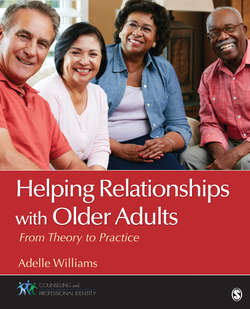Читать книгу Helping Relationships With Older Adults - Adelle M. Williams - Страница 53
На сайте Литреса книга снята с продажи.
Stereotypes
ОглавлениеOne of the problems with stereotyping is that people sometimes act on these oversimplified assumptions, which leads to age discrimination. Older workers have been discriminated against on the basis of the stereotypes that they are unable to learn new things, are less productive than younger workers, are more likely to miss work because of sickness, and are set in their ways. Even though all of these stereotypes have been disproven by research, they still persist.
Consequences of stereotyping have been examined. There is a new line of research showing that older people internalize negative stereotypes and that these aging self-stereotypes can influence cognitive and physical health (Levy, 2002). Hess, Hinson, and Stratham (2004) studied the ways in which positive and negative stereotypes influence older adults’ performance on a memory task. Participants who were exposed to negative stereotypes performed more poorly than those who were primed with positive stereotypes. Additionally, the concept of “stereotype threat” is used to help explain the impact of stereotypes on memory, cognition, and health. It suggests that when individuals are afraid that their behavior will reinforce a negative stereotype about a group to which they belong, their performance is affected.
Age stereotypes are communicated in numerous ways. Television programs, advertisements, jokes, and birthday cards are often full of age stereotypes. Stereotypes stem from society’s need to simplify the social world through the creation of categories, and they are related to age norms that suggest certain roles and behavior as appropriate at certain ages and not at others. From these benign or neutral starting points, age stereotypes can lead to age discrimination and aging self-stereotypes and can thus affect the psychological and social quality of life for older people.
Guided Practice Exercise 2.2 provides an opportunity to explore ways to replace stereotypes and myths regarding aging with factual information.
Guided Practice Exercise 2.2
Many individuals fear growing older and there exists stereotypes and myths associated with aging. Identify ways you would dispel myths and stereotypes of aging. At what levels would you suggest target areas? How would you suggest integrating aging content into a curriculum at an early developmental stage?
Case Illustration 2.1 provides a glimpse of how preconceived ideas on the part of the professional counselor can impede the development of a trusting therapeutic relationship with an older client seeking services.
Case Illustration 2.1
Ageism is one of the negative consequences experienced by some elders in today’s society. Differential treatment of older clients may occur in mental health settings, which lead to underutilization of mental health services. Ms. Timmons is a 75-year-old female who is self-referred to an outpatient mental health facility. Her presenting symptoms include difficulty sleeping, appetite disturbance, lack of interest in activities, and other symptoms related to a diagnosis of depression.
The professional counselor greets Ms. Timmons using her first name. She proceeds by speaking loudly to Ms. Timmons in a childlike manner. She then escorts Ms. Timmons to her office, placing her arm around Ms. Timmons’ arm, despite the fact that Ms. Timmons is fully ambulatory. During the initial intake assessment, the counselor is interrupted several times with incoming phone calls. The counselor was very directive in her approach and used a depressive screening instrument to determine the extent of the symptoms and level of severity. This instrument was not normed on older adults, but one she typically uses with adult clients. Ms. Timmons did not complete the assessment, as she felt rushed and was given little opportunity to express other issues she was experiencing. Ms. Timmons had just experienced the loss of her pet of 12 years, foreclosure of her home, relocation of her major support system (her daughter moved out of state), and loss of her driver’s license. These areas were not addressed, and Ms. Timmons did not return for her follow-up session.
